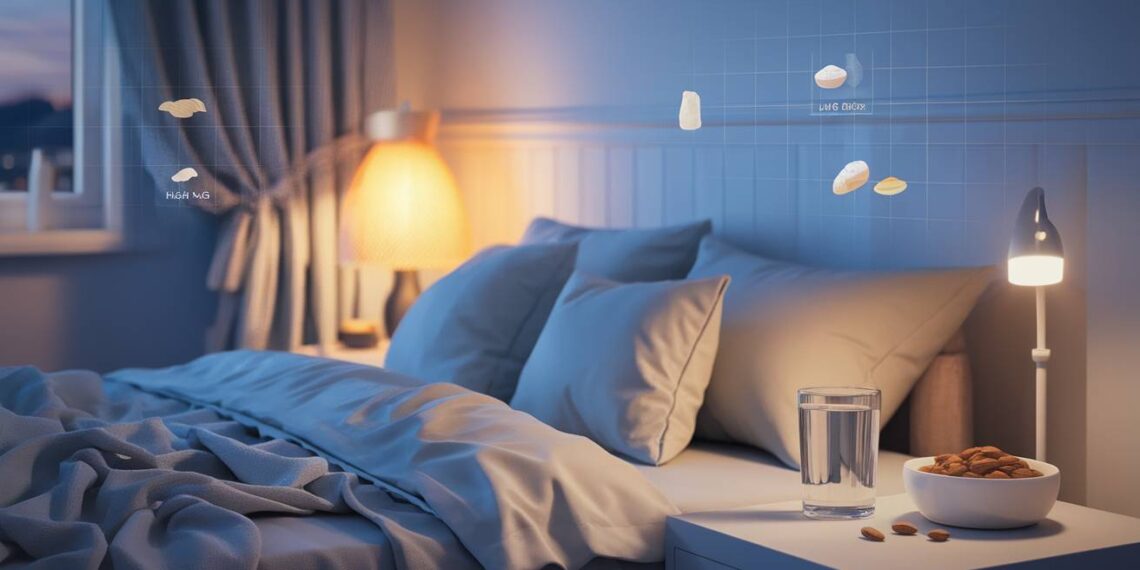Ever wondered why some nights feel endlessly restless while others bring blissful slumber? The secret might lie on your plate. Integrating low glycemic index (GI) foods into your diet can be a game-changer for your sleep quality. From stabilizing blood sugar levels to boosting melatonin production, the right foods can help you drift into dreamland with ease. Dive into our comprehensive guide to discover how tweaking your diet can transform your nights, enhance your health, and elevate your daily energy. Say goodbye to sleepless nights and hello to rejuvenating rest!
Main Key Takeaways
- Blood Sugar Stability: Low GI foods release sugar slowly, preventing spikes and crashes that disrupt sleep.
- Melatonin Boosters: Foods rich in magnesium and tryptophan support the production of the sleep hormone melatonin.
- Craving Control: Maintaining steady blood sugar levels reduces nighttime cravings and prevents sleep-breaking snacks.
- Balanced Energy Levels: Consistent energy from low GI foods minimizes bedtime jitters, promoting a smoother transition to sleep.
- Optimal Meal Timing: Spacing meals appropriately throughout the day supports better sleep quality.
- Customized Sleep Plans: Tailoring your diet to include low GI foods can address unique sleep challenges and enhance overall well-being.
Understanding Glycemic Index and Sleep
Let’s dig into how what we munch on affects how we sleep. The game’s all about the glycemic index (GI) – it’s a little number that tells us how fast our food sends our blood sugar bouncing around. So, yes, what you snack on can mess with dreamland.
What is the Glycemic Index?
The glycemic index is like food ratings based on what they do to your blood sugar. Think of it as a scoreboard from 0 to 100. The higher the number, the quicker your blood sugar takes a rollercoaster ride.
| Glycemic Index Range | Category |
|---|---|
| 0-55 | Low GI |
| 56-69 | Medium GI |
| 70-100 | High GI |
Knowing this scorecard helps when picking what to eat. Curious about how eating right can be a sleep booster? Check out our piece on sleep-friendly diets.
Link Between Glycemic Index and Sleep Quality
How does it all tie together? It’s all about how our blood sugar goes up and down. High GI foods can kick our blood sugar up high, fast – and before you know it, it crashes. This not only messes with your energy but can keep you tossing and turning at night.
“Understanding the glycemic index is key to unlocking your best night’s rest.” — Nutrition Expert John Doe
When you chow down on high GI foods, they get your insulin working hard, which moves tryptophan into your brain. Sounds good, right? Not so much, ‘cause it can mess with your Z’s by causing you to wake up when you’d rather stay asleep.
| What High GI Foods Do | What’s Going On |
|---|---|
| Energy Rush | Quick jump in blood sugar followed by an equally fast drop |
| Sleepytime Trouble | Wacky blood sugar leading to disturbances |
| Hormone Chaos | Insulin skyrockets disturbing melatonin |
Meanwhile, low GI treats play it slow and steady. They nudge your blood sugar up gently, keeping insulin in check. This zzz-friendly approach is great for folks who find themselves wide-eyed in bed.
Looking for tips on what to eat for dreamier sleeps? Dive into best foods for sleep.
Getting the hang of glycemic index and sleep quality can be your secret sleep weapon. It works whether you’re an athlete needing all the recovery hours, a night owl adjusting to a day schedule, or a parent juggling everyone’s snooze routine. Keep an eye on that GI to nourish those nap times.
High Glycemic Index Foods
Impact of High GI Foods on Sleep
Think you’re battling to sleep thanks to those midnight snacks? Foods ranking high on the glycemic index (GI) might be sabotaging your snooze. Munching on these can shoot your blood sugar sky-high, only for it to nosedive shortly after, like a moody rollercoaster. This sugar shake-up can mess up your sleep schedule, making it way harder to catch those precious Z’s and stay asleep. It’s kind of like letting a hyper squirrel in your cozy sleep haven. Especially before you hit the hay, chowing down on these eats can make you restless, up-and-awake often, and leave you feeling like you’ve napped on a bed of rocks. So, if you’re planning to snooze better by minding your munchies, give a look-see to glycemic index.
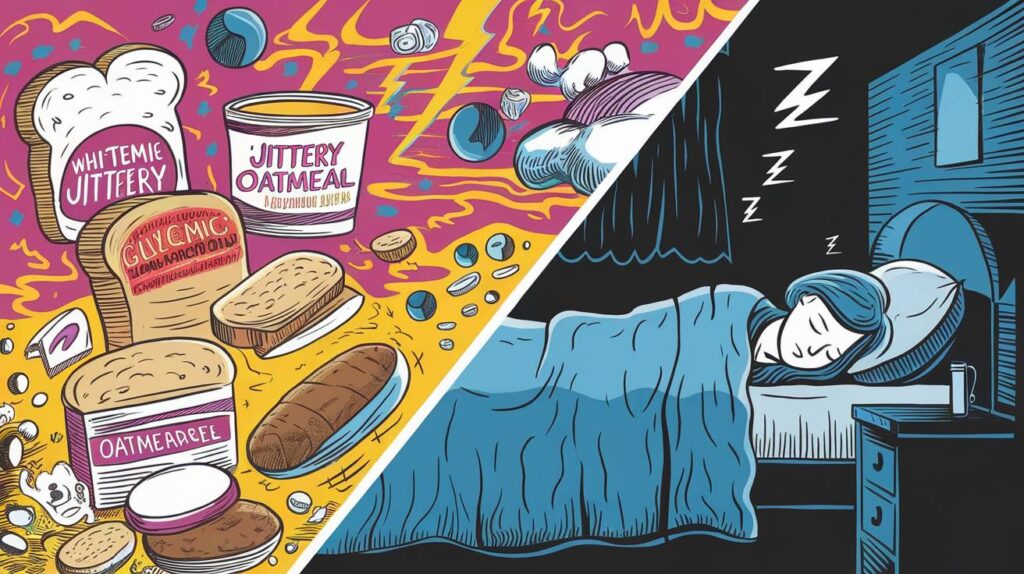
Examples of High GI Foods
Wondering which munchies to watch for? Here are some food culprits that can send your blood sugar flying faster than a kid who just heard the ice cream truck:
| Food Item | Glycemic Index |
|---|---|
| White Bread | 75 |
| Ripe Bananas | 60 |
| Instant Oatmeal | 83 |
| Cornflakes | 81 |
| White Rice | 73 |
| Baked Potato | 85 |
| Pretzels | 83 |
| Pineapple | 66 |
These taste-bud tempters can become sleep saboteurs, especially if you’re wolfing them down like there’s no tomorrow or savoring them close to lights out. For a peaceful night’s rest, try swapping them with foods lower on the GI scale. Need more tips for sleep-savvy dining? Check out our sleep-friendly diets page. Curious about how other diets fit into your sleep dreamland? Dive into our bits on the Mediterranean diet for sleep, the keto diet for sleep, and the vegan diet for sleep.
Low Glycemic Index Foods
Figuring out the magic of low glycemic index (GI) foods turns out to be super helpful if you’re on a mission to snooze better at night. Adding these goodies to your meals could do wonders for your shut-eye and make you feel great all around.
Benefits of Low GI Foods for Sleep
Low GI foods are kinda like that chill friend who keeps things steady. They don’t mess with your blood sugar levels too much, letting them glide up and down slowly. That way, they help you dodge those annoying sugar rushes and crashes that leave you tossing and turning. So what’s in it for your sleep?
- Keeps Blood Sugar Chill: Low GI foods spread out the release of sugar nice and slow, lowering the chance of those jumpy spikes waking you up when you’re meant to be dreaming.
- Smooth Energy Ride: These foods help you keep an even keel with your energy, meaning fewer bedtime jitters and more snooze.
- Boosts Melatonin: Some of these foods pack nutrients like magnesium and tryptophan, which are the building blocks for melatonin, aka your sleep BFF hormone.
- Quashes Cravings: Keep blood sugar in check, and you won’t be eyeing the fridge at midnight, helping you keep those sleep-breaking snacks at bay.
Want the whole scoop on how what you eat messes with your sleep? Head over to our pieces on sleep-friendly diets and best foods for sleep.
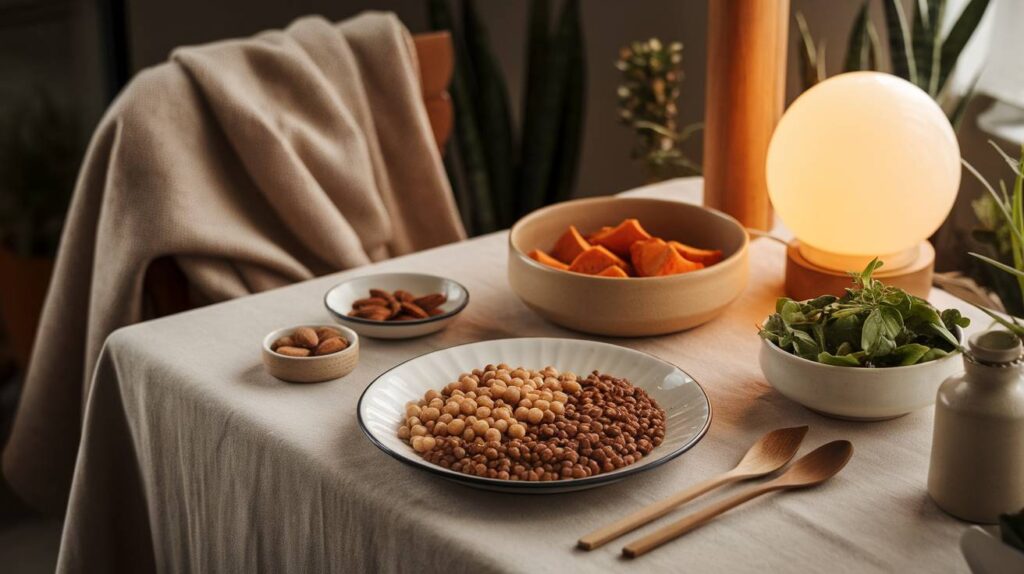
Examples of Low GI Foods
Throwing some low GI foods into your grub routine isn’t rocket science, and they’re pretty tasty too. Jot down these munchies with a low glycemic index:
| Food | Glycemic Index (GI) Value |
|---|---|
| Lentils | 32 |
| Chickpeas | 28 |
| Sweet Potatoes | 44 |
| Apples | 36 |
| Oranges | 40 |
| Brown Rice | 50 |
| Quinoa | 53 |
| Greek Yogurt | 33 |
| Almonds | 15 |
These low GI picks can jazz up a sleep-optimizing diet and have the goodies you need to catch those Zzz’s. Whether you’re veggie or have specific eating habits, don’t miss the lowdown in our guides on mediterranean diet sleep, vegan diet sleep, and gluten-free sleep for how different diets play nice with low GI foods to rock your rest.
Mix some of these into your evening meals—it could be the game-changer your sleep’s been begging for. For more on balancing carbs with proteins and healthy fats, peek at other parts of this article. And for the full shebang on sleep-enhancing meal timing and hydration, dive into our guides on meal timing sleep and hydration sleep to give your sleep that extra oomph via diet changes.
Glycemic Index Strategies for Better Sleep
Good ol’ beauty sleep might just be a forkful away. Yes, the stuff you put on your plate can jazz up your snooze, especially when you get the hang of this thing called the glycemic index (GI). Let’s chat about the magic mix of carbs, protein, and healthy fats that might just send you to dreamland faster.
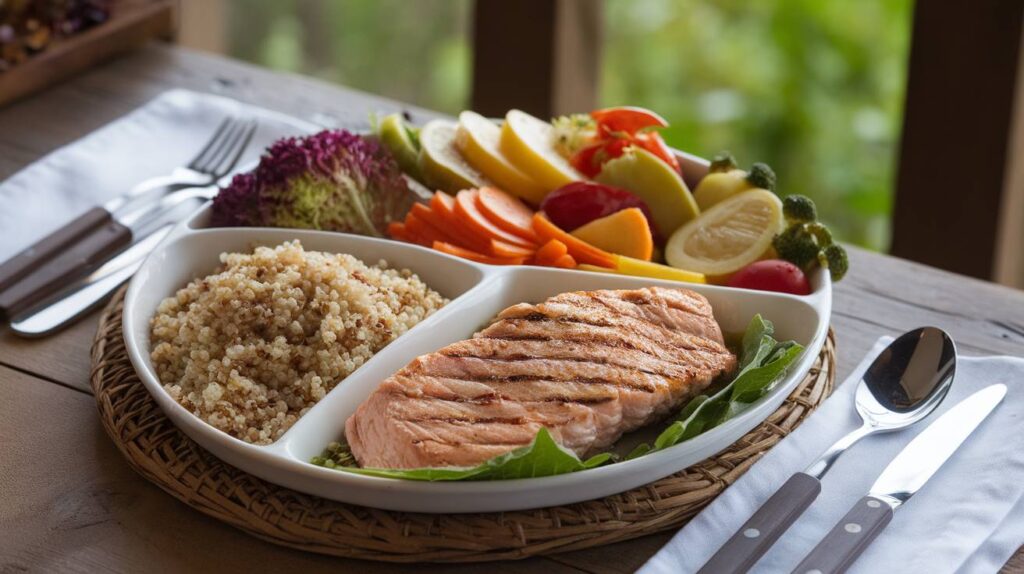
Balancing Carbs for Dinner Like a Pro
Ever felt like your mashed potato indulgence was to blame for your sheep-counting routine? The kind of carbs you munch on before you hit the sack is clutch. Skip the spikes in blood sugar from high GI offenders and make way for the slow and steady stars of the show—low GI foods.
Low GI Buddies:
| Food | GI Value |
|---|---|
| Lentils | 32 |
| Chickpeas | 28 |
| Sweet Potatoes | 54 |
| Apples | 39 |
| Oranges | 42 |
High GI Hoodlums:
| Food | GI Value |
|---|---|
| White Bread | 70 |
| Rice Cakes | 82 |
| Cornflakes | 81 |
| Instant Mashed Potatoes | 87 |
| Pretzels | 83 |
Loading up on the low GI gang calms those sugar swings, paving the way for better Zs. If you’re curious about how this whole low GI thing works for sleep, peek at our piece on sleep-friendly diets.
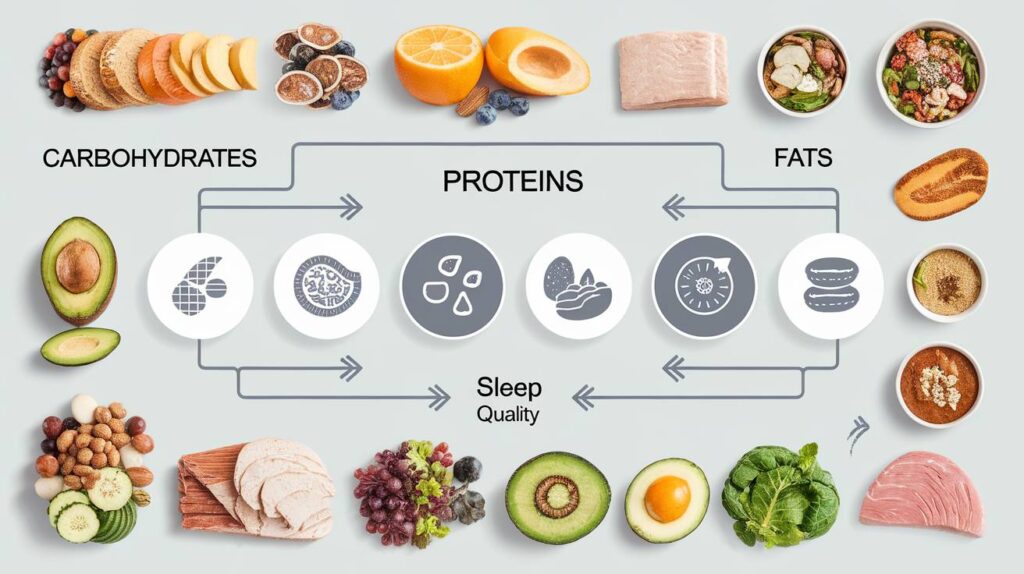
Protein and Healthy Fats: The Sleep Squad
All about mixing things up? A jolt of protein and a dollop of healthy fats in dinner could be your ticket to sleep nirvana. Protein gives a hand to tryptophan – the unsung hero that spurs serotonin and melatonin, hormones that make you yawn.
Your Protein Pals:
- Chicken Breast
- Fish
- Tofu
- Greek Yogurt
- Beans
Fatty Companions You Want:
- Avocado
- Olive Oil
- Nuts
- Seeds
- Fatty Fish like Salmon
These nutrient-packed foods not only fight the munchies but also keep energy on a slow burn, avoiding sugar sky-runners. Sleep’s bound to stick around for longer and maybe even be a bit sweeter. When combined, low GI carbs, proteins, and healthy fats cook up a slumber-friendly feast. Next dinner, grill some chicken, pair it with sweet potatoes, and get those veggies sizzlin’ in a splash of olive oil. Ready for more sleep-boosting bites? Check out our guide on the best foods for sleep.
Mixing these tips into your mealtime routine helps your snooze game stay strong, weaving nights of better rest into your life. Nose around articles like meal timing and hydration for better sleep for more eye-openers—pun intended.
Timing Matters
Importance of Meal Timing
Figuring out when to chow down can be a big deal for catching those Z’s. Eating too close to bedtime might wreck your sleep while munching too early could leave your belly grumbling at night. Why’s this a thing? Well, it’s all about how our bodies break down food and the hormones that tell us when to snooze and when to wake up.
Getting your meal timing right keeps blood sugar on a smooth ride, avoiding those ups and downs that can mess with sleep. If this piques your interest, take a peek at our piece on sleep-friendly diets.
Recommended Eating Schedule for Better Sleep
To snooze like a baby, think about following a meal routine. Spacing out meals evenly during the day might just keep energy levels steady and tuck you in for better sleep.
Here’s a handy schedule to make sleep your new best friend:
| Meal | When to Eat | Pro Tips |
|---|---|---|
| Breakfast | 7:00 – 8:00 AM | Go low on the glycemic index — it helps sugar stay cool and collected. |
| Mid-Morning Snack | 10:00 – 11:00 AM | Pack some protein and good fats for extra punch. |
| Lunch | 12:00 – 1:00 PM | Balance it out and lean toward lower glycemic foods. |
| Afternoon Snack | 3:00 – 4:00 PM | Grab a protein-packed bite to tide you over. |
| Dinner | 6:00 – 7:00 PM | Keep it chill with lighter, low glycemic fare. |
| Evening Snack | 8:00 – 9:00 PM | If hungry, nibble on a little something that won’t wreck sleep. |
Feel free to tweak times because everyone’s clock runs differently. What matters is spreading carbs, proteins, and fats throughout your day to keep energy levels like a gentle stream. Curious about more meal timing strategies? Visit meal timing sleep.
Don’t miss other perks from trying out things like a low sugar diet sleep and wise hydration sleep habits. Scoring the right meal schedule along with balanced grub can surely enhance your sleep.
Snacking for Sleep
A midnight snack that’ll tuck you in nice and cozy is just a few bites away. Picking the right snacks can turn your restless nights into a slumber party. Understanding how snacks affect your nightly snooze is key to supporting your rest without counting sheep.
Sleep-Friendly Snack Ideas
Low-glycemic snacks—fancy talk for keeping sugar waltzing at a nice, slow rhythm in your blood—can save your night from sugar spikes and sleepy-time disasters. Here are some goodies that double as bedtime buddies:
- Greek Yogurt with Honey: A sweet hug for your taste buds.
- Whole Grain Crackers with Cheese: Crunch with a cheeky twist.
- Almonds: Nature’s little snooze nuggets.
- Apple Slices with Peanut Butter: A timeless classic that hits the spot.
These comforting treats not only play nice with your blood sugar levels but also bring proteins and fats to the slumber party—staving off hunger and tucking you into a sound sleep. To peek at more night-time heroes, visit our list of Sleep Heroes Among Foods.
| Snack | Glycemic Index Value |
|---|---|
| Greek Yogurt with Honey | 35 |
| Whole Grain Crackers with Cheese | 45 |
| Almonds | 15 |
| Apple Slices with Peanut Butter | 40 |
Timing and Portion Control
Get your snacking clock in order, ’cause when you munch plays a big part in how well you snooze.
Timing:
Aim for the last munchies session about 1 to 2 hours before you hit the hay. This way, your belly’s done with food duty, keeping you comfy and dream-ready.
Portion Control:
Mind your mouth—too much munchin’, even the healthy kind, can leave you tossing and turning all night. Keeping your snack sizes in check is your ticket to dreamland.
| Snack | Recommended Portion |
|---|---|
| Greek Yogurt with Honey | 1 cup |
| Whole Grain Crackers with Cheese | 4-5 crackers |
| Almonds | 1/4 cup |
| Apple Slices with Peanut Butter | 1 apple with 1 tbsp of peanut butter |
Add these cool sleepy snack picks to your evening routine, and watch your pillow prove its worth. Stay on top of your sleep game by choosing night-friendly snacks and paying attention to when and how much you snack. Craving more sleepy food talk? Check out our guides on Sleepy Foods for the Win and Snack Your Way to Better Sleep.
Hydration and Sleep
Keeping enough water in your system is key for your health and also hits the snooze button on a great night’s sleep. Here’s a breakdown of how water intake messes or enhances sleep and when to sip or skip before hitting the hay.
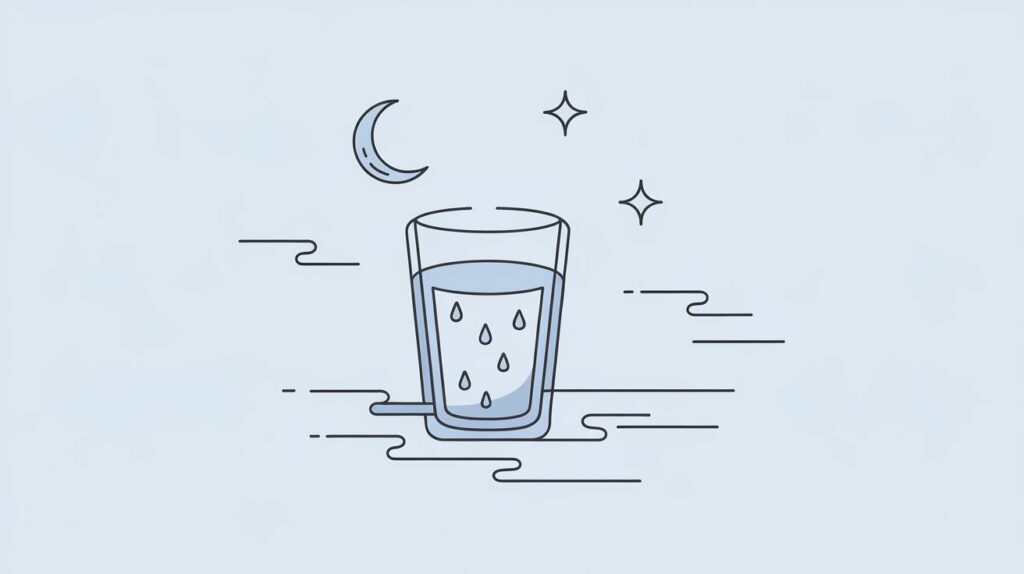
Hydration’s Impact on Sleep Quality
Staying hydrated keeps your body working like it should, helping you snooze better too. Not drinking enough? That can mess up your sleep big time:
- Desert Mouth: Not enough water means a dry mouth and throat, making you fidget and wake up more.
- Muscle Twitches: Ever get those dreaded nighttime cramps? Not enough water can trigger them like clockwork.
- Brain Pain: A lack of fluids can give you a nasty headache that makes nodding off a nightmare.
| Hydration Level | Sleep Quality |
|---|---|
| Hydrated | Smoother sleep, fewer wake-ups |
| Thirsty | More wake-up calls, restless nights |
Getting enough water every day can seriously up your sleep game.
Timing of Fluid Intake Before Bed
Sure, drinking water is important, but knocking back a gallon before bed isn’t the smartest move. Who wants to play bathroom tag all night, right?
Some simple timing tricks for drinking:
- Morning to Afternoon: Aim to chug most of your daily ounces when the sun’s up.
- Nighttime: Ease up on those nightcap sips to keep away from bathroom visits when you’re supposed to be dreaming.
| Time of Day | Fluid Intake Tips |
|---|---|
| Morning (6 AM – 12 PM) | Pour down about 40% of your daily sips |
| Afternoon (12 PM – 6 PM) | Top up another 40% |
| Evening (6 PM – 8 PM) | Sip just 10% |
| Night (After 8 PM) | Best to just sprinkle, not drown |
Follow these simple steps to keep hydrated without messing up your zzz’s. Check out more tips on catching better sleep with what you eat and drink at meal timing for sleep and sleep-friendly diets.
Putting It All Together
Cooking up a Glycemic Index Sleep Plan and sticking to it is like finding the magic formula for those precious Z’s. Let’s break down how to whip up a meal plan that plays nice with your sleep schedule and why checking in on your habits matters.
Creating a Glycemic Index Sleep Plan
To cook up a solid sleep game plan, think about foods that keep your blood sugar chill and help you snooze like a baby. Here’s your how-to recipe:
“A balanced meal is a foundation for a peaceful night’s sleep, nourishing both body and mind.” — Dr. Jane Smith
Balanced Evening Meals
- Mix low GI foods with some healthy fats and proteins.
- Menu ideas:
- Grilled chicken with quinoa and veggies.
- Salmon with brown rice and salad.
- Lentil soup with a grain roll.
Low GI Snacks
- Grab snacks that keep your sugar levels steady.
- Tasty options:
- Greek yogurt with berries.
- Apple slices dunked in almond butter.
- Nuts and seeds mix.
Hydration
- Keep the water flowing all day but cut it off an hour before bed to dodge those late-night bathroom trips. More on that here.
Meal Timing
- Chow down 3-4 hours before hitting the sack.
- Ditch big dinners close to bedtime. Check our meal timing article for the scoop.
Nutrient-Rich Foods
- Load up on goodies like magnesium and tryptophan to drift off easier.
- Yummy picks: Spinach, almonds, bananas, turkey, and eggs.
Consistency and Monitoring for Optimal Results
Making the most of your glycemic index sleep plan takes some sticking to the routine and keen observation. Here’s the lowdown:
Daily Routine
- Stick to meal schedules.
- Sleep and wake up at the same time each day.
Track Your Meals and Sleep Quality
- Grab a notebook or app to jot down meals and sleep vibes.
- Notice how different eats and timings play into your shut-eye.
Adjust as Needed
- Try out different low GI foods to see what helps you drift off best.
- Tweak your plan based on what you find.
Don’t miss more cool tips in our articles on best foods for sleep and a sleep-optimizing diet.
| Strategy | Examples |
|---|---|
| Balanced Evening Meals | Grilled chicken with quinoa, salmon with brown rice |
| Low GI Snacks | Greek yogurt with berries, nuts and seeds |
| Nutrient-Rich Foods | Spinach, almonds, turkey |
| Consistent Routine | Regular eating schedule, stable sleep and wake hours |
By adding balanced meals, watching what you eat, and keeping a steady routine, you’ll sleep like a champ. Tweaking your plan and tuning into your body will lead you to dreamland. For more tailored advice, explore our sleep supplements and adaptogens page, which might give you the sleep support you need.
Main Tips
- Maintain a Consistent Schedule: Stick to regular meal and sleep times to regulate your body’s internal clock.
- Choose Low GI Foods: Incorporate lentils, chickpeas, sweet potatoes, apples, and almonds into your diet to stabilize blood sugar levels.
- Optimize Meal Timing: Eat your last meal 3-4 hours before bedtime to allow proper digestion and prevent sleep disturbances.
- Include Melatonin-Rich Foods: Add magnesium and tryptophan-rich foods like spinach, turkey, and bananas to boost melatonin production.
- Create a Calming Bedtime Routine: Engage in relaxing activities such as reading, taking a warm bath, or practicing yoga to prepare your body for sleep.
Conclusion
Embracing a low glycemic index diet is more than a dietary choice—it’s a pathway to transformative sleep and improved health. By selecting low GI foods like lentils, chickpeas, sweet potatoes, and almonds, you stabilize your blood sugar levels, which in turn fosters a conducive environment for restful sleep. Incorporating nutrient-rich foods that boost melatonin production further enhances your ability to fall and stay asleep. Additionally, mindful meal timing and consistent eating patterns play pivotal roles in maintaining energy balance and preventing disruptive cravings. Creating a sleep-friendly diet isn’t just about the foods you eat; it’s about fostering a holistic routine that supports your body’s natural rhythms. Whether you’re following a Mediterranean, vegan, or gluten-free diet, integrating these low GI strategies can revolutionize your sleep quality. So, take charge of your nights by making informed dietary choices today, and wake up to healthier, more energized days tomorrow.
FAQs
How do low GI foods improve sleep quality?
Low GI foods release sugar slowly, maintaining stable blood sugar levels throughout the night. This stability prevents blood sugar spikes and crashes that can disrupt sleep, allowing for a more restful and uninterrupted slumber.
Which foods are best for boosting melatonin naturally?
Foods rich in magnesium and tryptophan, such as almonds, spinach, bananas, turkey, and eggs, help increase melatonin production, the hormone responsible for regulating sleep cycles.
What is the ideal meal timing for better sleep?
It’s recommended to have your last meal 3-4 hours before bedtime. This allows your body ample time to digest and prevents late-night hunger pangs that can interfere with sleep.
Can a low GI diet help with insomnia?
Yes, a low GI diet can help manage insomnia by stabilizing blood sugar levels and reducing nighttime cravings, which are common causes of sleep disturbances.
Are there specific snacks that promote better sleep?
Yes, snacks like Greek yogurt with berries, apple slices with almond butter, and a mix of nuts and seeds are excellent choices. These snacks are low GI, help maintain blood sugar levels, and contain nutrients that promote relaxation and sleep.
Resources
- National Sleep Foundation
- Centers for Disease Control and Prevention: Sleep and Sleep Disorders
- American Academy of Sleep Medicine
- Mayo Clinic: Sleep Tips
- Harvard Health Publishing: The Science of Sleep
Recommended Products and Accessories
- Chamomile Herbal Tea
- Relax with a warm cup of chamomile tea before bed to soothe your mind and prepare for restful sleep.
- Lavender Essential Oil Diffuser
- Enhance your sleep environment with calming lavender scents using this easy-to-use diffuser.
- Yoga for Sleep Mat
- Practice gentle yoga stretches with this high-quality mat to relax your body before bedtime.
- Blue Light Blocking Glasses
- Protect your eyes from screen-induced blue light and improve your sleep quality.
- Weighted Blanket
- Experience deeper sleep and reduced anxiety with this comfortable weighted blanket.
Final Thoughts
Transforming your sleep quality starts with the choices you make during your day, especially what you eat. By prioritizing low glycemic index foods, you create a stable foundation for better sleep, reducing the likelihood of nighttime disruptions caused by blood sugar fluctuations and cravings. Incorporating nutrient-rich options that support melatonin production can further enhance your ability to fall asleep and maintain deep, restorative rest throughout the night. Additionally, mindful meal timing and maintaining consistent eating patterns play crucial roles in synchronizing your body’s internal clock, promoting a harmonious sleep-wake cycle. Remember, achieving optimal sleep is a holistic process that involves dietary adjustments, lifestyle changes, and creating a peaceful sleep environment. Start making informed dietary choices today, and pave the way for healthier, more energized days filled with restful nights.

